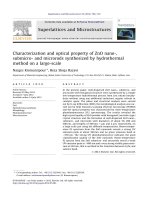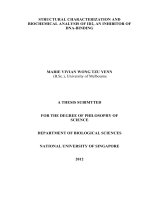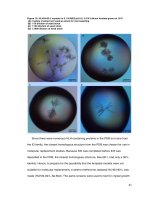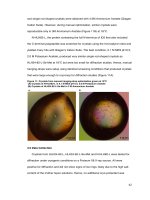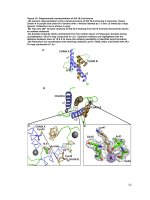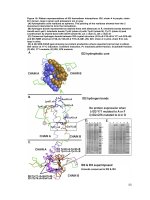Morphological characterization and genetic diversity of Fusarium spp. infecting bitter gourd
Bạn đang xem bản rút gọn của tài liệu. Xem và tải ngay bản đầy đủ của tài liệu tại đây (745.6 KB, 11 trang )
Int.J.Curr.Microbiol.App.Sci (2020) 9(5): 818-828
International Journal of Current Microbiology and Applied Sciences
ISSN: 2319-7706 Volume 9 Number 5 (2020)
Journal homepage:
Original Research Article
/>
Morphological Characterization and Genetic Diversity of Fusarium spp.
Infecting Bitter Gourd
M. Saran Kumar1*, S. K. Manoranjitham1, V. Sendhilvel1 and V. Rajasree2
1
Department of Plant Pathology, Tamil Nadu Agricultural University,
Coimbatore – 641 003, India
2
Department of Vegetable Science, Tamil Nadu Agricultural University,
Coimbatore – 641 003, India
*Corresponding author
ABSTRACT
Keywords
Bitter gourd,
Fusarium spp.,
Pathogenicity, PCR
amplification,
Genetic diversity.
Article Info
Accepted:
05 April 2020
Available Online:
10 May 2020
Bitter gourd (Momordica charantiaL.) is an important cucurbitaceous plant in which the deleterious
diseases namely vascular wilt, damping off occurs commonly and causes 30 to 50 percent losses in crop.
The present investigation was aimed to study the morphological and molecular characterization of disease
causing pathogen to understand the etiology of the disease.Survey was conducted at different locations of
Coimbatore, Erode and Dharmapuri and samples were collected for the isolation of the pathogen. The
pathogen was isolated from the brownish discoloured vascular tissue of stem portion which was typically
wilted. Pathogenicity assay was proved and the virulence of the fusarium isolates were identified under
artificial inoculation studies. The morphological studies of Fusarium isolates were studied using the
microscopic observation to study the micro and macro conidial variation .The molecular confirmation of
pathogen was done by PCR amplification using ITS 1 and ITS 4primer at 560 bp. The different species of
Fusarium solani, Fusarium equiseti, Fusarium falciforme, Fusarium chlamydosporum and Fusarium
incarnatumwere identified in these molecular studies. Among the species, Fusarium solani is a major
pathogen associated with bitter gourd wilt disease. The genetic variability studies among different
Fusariumspp. was carried out using RAPD marker. The variability studies revealed that virulence isolates
viz, F. solani VP, F. solani EL, F. solani TP, F. falciforme IJ and F. chlamydosporum TN were grouped
into cluster II which are more virulent and the same results were shown in pathogenicity. The wilt
pathogen of bitter gourd isolated from the palee hybrid was shown more virulence when compared to the
other isolates.
immature fruits and tender vine tips are used.
It is a most common vegetable cultivated
throughout India during warm season (Satkar
et al., 2013). Bitter gourd has been used in
various
herbal
medicine
systems.
Phytochemical compounds like dietary fiber,
minerals,
vitamins,
flavonoids
and
antioxidants involved in health promoting and
Introduction
Bitter gourd (Momordica charantia L.) is one
of the important cucurbitaceous vegetable
grown in India. Among the cucurbits, it is
prized vegetable which is having high
nutritive value especially ascorbic acid and
iron (Behera2004). For culinary preparations
818
Int.J.Curr.Microbiol.App.Sci (2020) 9(5): 818-828
disease prevention. It is also used for
reduction of blood sugar levels in the
treatment of type-2 diabete (Singh et al.,
2013). The crop is cultivated with an area of
99,000 ha in India with an annual production
of 11,98,000 MT and the productivity of
12.18MT/ha (Indiastat 2018-19). Wilt disease
caused by Fusarium spp. the main constraint
with bitter gourd cultivation in India.
(Tamilselvi2014). It is the most devastating
soil borne disease and one of the major yields
limiting constraint which cause profound
economic losses ranging from 30 to 50 per
cent under dry warm conditions (Tamilselvi
and Pugalendhi 2015). The knowledge on
host pathogen interaction and predominating
of causative agents are not explained. Hence
considering this idea in mind, the present
investigation was carried out to study the
morphological and molecular variability of
the pathogen and to the etiology of the
disease.
the day and eventual death. Brown stripes will
develop on stems and branches of infected
plants (Tamilselvi et al., 2016). Vascular
discoloration is visible inside the stem and
stem collarturn dark brown (Fig.1).
Isolation and purification of pathogen
The wilt infected vascular tissue was taken
from the infected parts of the plant, sterilized
in a 0.5% sodium hypochlorite solution,
rinsed with sterilized water for three times
and placed on Potato Dextrose Agar (PDA)
medium. The medium was supplemented with
0.5gL-1 of streptomycin sulphate to avoid the
bacterial contamination. After that the Petri
dishes were incubated at 25±1°C for 7 days
(Muhammad et al., 2019). The colony
produced from diseased sample were reisolated using a single spore where the fungal
colonies emerged from diseased samples were
transferred to different Petri dishes containing
fresh PDA medium for pure culture.
Materials and Methods
Pathogenicity
Survey and collection of plant materials
In order to confirm the pathogenic nature of
isolated fungal pathogen, the pathogenicity
test was conducted in earthen pots.
The survey was conducted in around
Coimbatore, Erode and Dharmapuri districts
of Tamil Nadu. Thediseased plants showing
typical disease symptom were collected from
ten different fields. Thetotal numbers of
plants wilted were recorded in sq. meter of
area and the Percent Disease Incidence (PDI)
was calculated for each field location as
methodology explained by Muhammad et al.,
(2019).
Inoculum preparation and inoculation
Sand maize medium was used for mass
multiplication of the fungal isolate in the
laboratory. The medium was prepared with
ratio of 19:1 sterilized in an autoclave at 15
lbs psi for 30 minutes. Sand maize medium
was inoculated with pure culture of Fusarium
isolates in aseptic conditions and incubated in
an incubator at 28 + 20C for 15 days
(Ashwathi et al., 2017).
Symptomatology
A symptom of fusarium wilt includes
damping-off, seedling disease or wilt during
any stage of plant development. Symptoms on
mature plants typically appear as a dull grey
green appearance of the leaves followed by
yellowing of the crown foliage, wilting during
Preparation of planting material
Bitter gourd seeds CO1 were sown in the
earthen pots containing sterilized potting soil.
819
Int.J.Curr.Microbiol.App.Sci (2020) 9(5): 818-828
Sand maize medium was prepared and mixed
with proportion of 100mg inoculum/kg of
potting mixture and sowing was taken.
Morphological
and
identification of pathogen
USA) gel electrophoresis (Karthick et al.,
2019a). The quality and quantity of isolated
DNA were checked by NanoDrop
Spectrophotometer
(ND2000,
Thermo
Scientific, USA). Finally, The PCR products
were purified and used for sequencing
analysis in Barcode Bioscience Pvt ltd,
Bangalore(India). The sequenced data were
analysed using similarities of nucleotide
sequences between isolates through the
BLAST
procedure
().
microscopic
The fungal pure culture was transferred to
new Potato Dextrose Agar (PDA) to facilitate
for the growth of mycelia and sporulation of
conidia for the identification of pathogen
through Labomed camera model LX400
microscope with image analyser pixel pro
program at 40x magnification using sterile
water (Karthick et al., 2019). The pathogens
were identified based on the microscopic
analysis, microconidia and macroconidia
characteristics such as colour, shape and size,
and also the presence chlamydospore were
studied and tabulated.
Molecular variability studies
RAPD-PCR analysis of fusarium spp.
Genotypic characterization of the Fusarium
spp. isolateswas done by using a PCR-based
fingerprinting
of
randomly amplified
polymorphic DNA (RAPD) markers method
described by Bentley et al., (1995). PCR
amplification was performed using an
Eppendorf nexus gradient master cycler and a
20μl total volume containing 2.0 units of Taq
polymerase (Bangalore Genei Pvt Ltd, India),
2μl of 10X buffer, 1.5μl of 2.5 mM MgCl2,
1μl of 2.5 mM dNTP, 2μl of 10μM primer,
4μl of genomic DNA and sterile distilled
water. The PCR was performed, using
Eppendorf – Master Cycler nexus gradient S
(Eppendorf, A G, Hamburg, Germany), with
an initial denaturation step for 5 min at 94°C,
followed by 35 cycles of 1 min for
denaturation at 94°C, 1 min for annealing at
36°C and 1 min for extension at 72°C, with a
final extension for 5 min at 72°C. Following
amplification, 20μl of each PCR product was
separated by electrophoresis in 1.0% (w/v)
agarose gel in Tris-acetate-EDTA (TAE)
buffer.To
visualize
amplified
DNA,
fragments gels were stained with an ethidium
bromide (0.1 mg l–1) and then photographed
under transmission ultraviolet light, using an
Alpha Imager 2000 (Alpha Innotech, San
Leandro, CA, USA).
Molecular identification of the isolated
fungi
The pure fungal isolates were taken for the
DNA isolation using CTAB method described
by Chowdhury et al., (2019). The isolated
DNA were amplified through polymerase
Chain Reaction (PCR) technique using
universal primers, ITS1 (5’-TCC GTA GCT
GAA CCT GCC G-3’) and ITS4 (5’-TCC
TCC GCT TAT TGA TAT GC-3’) developed
by White et al., (1990) and Hot Start Green
Master Mix (Promega, USA). PCR was
performed in a 50μl reaction mixture
containing 25μl of Hot Start Green Master
Mix (2X), 2.0μl of each forward and reverse
primer, 2.0μl of genomic DNA and rest of the
PCR water. The performing PCR program
was as follows: pre heat at 95°C for 2 min,
followed by 40 cycles of denaturation step at
95°C for 1min, primer annealing at 58°C for
1min, primer extension at 72°C for 1min with
a final extension at 72°C for 5 min, hold at
10°C for overnight. The amplicons were
separated by 1% agarose (V3125, Promega,
820
Int.J.Curr.Microbiol.App.Sci (2020) 9(5): 818-828
The whole RAPD analyses experiment was
repeated at least three times for all primers
and isolates and only the RAPD bands which
appeared consistently were evaluated for
polymorphism. Using the software DARwin
6, the dendrogram constructed. The RAPD
primers are given below table.1.
Morphological and molecular identification
of pathogen
In morphological identification of pathogen,
Fusarium solani, macro conidia have slightly
curved and relatively thick with a slightly
hook cell were similar with the information
described by Leslie and Summerell (2006).
The hypha of the Fusarium spp. was hyaline,
septate, smooth and branched. The
microconidia were oval or falcate and
macroconidia were fusiform or falcate
(‘canoe-shaped’) having 3-5 septation with
large
in
numbers
(Table.4).
The
morphological variations were clearly
recorded that Fusarium solani macroconidia
was fusiform with moderately curved. In case
of F. chlamydosporum was shown that
slightly curved with fusiform macroconidia
which is varied from F. incarnatum and
shown fusiform to falcate. The macroconida
of F. equiseti was shown fusiform to falcate.
The different species of Fusarium were
recorded in bottle gourd crop and the species
like F. equiseti, F. moniliforme and F. solani
which is responsible for wilt disease (Shah et
al., 2014). The F. equiseti and F. oxysporum
are the causal agents which is mainly
responsible for causing fusarium wilt in bitter
gourd reported by Chowdhury et al., (2019).
Results and Discussion
Isolation and purification of pathogen
In this study, the different fusarium wilt
disease infected fields were surveyed which
showing typical symptoms. The wilt
pathogens were isolated and listed in the
Table.2. The results revealed that the disease
incidence was maximum at Madhampatti
(59.3%) followed by Papampatti (55.4%)
villages of Coimbatore district. The least
disease incidence (15.6%) was observed at
TNAU vegetable garden followed by the
Injampalayam (20.3%) Erode district.
Pathogenicity test
The assay on pathogenicity, plants were
shown different period of wilting incidence
after the inoculation of pathogen. After
inoculation of pathogen, plants initially had
shown yellowing of foliage, pale green
appearance of leaves, day wilting followed by
death. Inside the stem, vascular browning of
tissues was found (Fig.2).
Molecular identification of the isolated
fungi
To identify the Fusarium species associated
with bitter gourd wilt disease, the ITS 1 and 4
region PCR based amplification and
sequencing was carried out for the amplicon
of ~560bp. The results were coincided with
work of Chowdhury et al., (2019) who has
been confirmed Fusarium spp. infecting bitter
gourd in Bangladesh. On 1% agarose gel
electrophoresis, the genomic DNA isolated
from the fungal isolates showed higher
molecular weight and bright band, 1kb DNA
ladder was used as a marker.
The present findings were similar with the
Ashwathi et al., (2017) studies that the
fusarium wilt of coriander symptom
expression was observed under the sand
maize inoculation of pathogen which shown
reddish brown lesions at collar portion,
gridling and toppling down of seedlings on
15th day. The Koch’s postulates were proved.
This study revealed that the isolate Fusarium
solani was more virulent followed by
Fusarium equiseti(Table.3).
821
Int.J.Curr.Microbiol.App.Sci (2020) 9(5): 818-828
Table.1 RAPD primers used for genetic variability analysis
S.No
1.
2.
3.
4.
5.
6.
7.
8.
9.
10.
CODE
M1
M2
M3
M4
M5
M6
M7
M8
M9
M10
PRIMER
OPF 01 – 5’CCCAAGGTCC 3’
OPE 02 – 5’ GGTGCGGGAA 3’
OPE 03 – 5’ CCAGATGCAC 3’
OPA 04 – 5’ AATCGGGCTG 3’
OPA 05 – 5’AGTCAGCCAC 3’
OPF 06 – 5’ GGGAATTCGG 3’
OPA 07 – 5’ GAAACGGGTG 3’
OPF 08 – 5’ GGGATATCGG 3’
OPA 09 – 5’ GGGTAACGC 3’
OPA 11 – 5’ CAATCGCCGTS 3’
Table.2 Survey of Fusarium wilt in bittergourd in Coimbatore, Erode and Dharmapuri districts
for assessing disease incidence
S.NO
LOCATION/DIST
LATITUDE/
LONGITUD
E
SOIL
TYPE
STAGE
CODE
VARIETY
DISEASES
INCIDENCE
(%)
1.
Vettaikaranputhur
(Pollachi)
Papampatti (CBE)
10.5534°N /
76.8889°E
10.9434°N /
77.1126°E
12.3251°N /
78.0469°E
10.9945°N /
76.9248°E
10.9728°N /
76.8576°E
Red
calcareous
Red
calcareous
Black
calcareous
Black soil
Vegetative
VP
Palee
PA
Palee
DPI
Palee
TP
Palee
MA
Palee
32.8e
(35.59)
55.4b
(46.01)
45.5d
(41.53)
51.7c
(44.33)
59.3a
(47.78)
VPT
Palee
AR
Palee
EL
Palee
IJ
Palee
TN
Co 1
2.
3.
4.
5.
6.
7.
8.
9.
10.
Theetharahalli
(Dharmapuri)
Thelungupalayam
(CBE)
Madhampatti
(CBE)
Vadugapatti
(Erode)
Archalur (Erode)
Elumathur
(Erode)
Injampalayam
(Erode)
TNAU (CBE)
11.1281°N /
77.7406°E
11.1176°N /
77.6881°E
11.1868°N /
77.7738°E
11.2043°N /
77.8196°E
11.0123°N /
76.9355°E
Harvesting
(IInd Picking)
Harvesting
(Ist Picking)
Harvesting
(IIst Picking)
Red loamy Harvesting
(IIIrd
Picking)
Deep
Harvesting
loamy soil (Ist Picking)
Red loamy Harvesting
(Ist Picking)
Deep
Harvesting
loamy soil (IInd Picking)
Black
Harvesting
calcareous (Ist Picking)
Loamy
vegetative
*Values are mean of three replicates
Values in parentheses are arcsine transformed values
In a column, means followed by a common letter are not significantly different at the 5% level by DMRT
822
26.3f
(32.51)
24.5g
(31.34)
31.8e
(35.10)
20.3h
(28.97)
15.6i
(26.05)
Int.J.Curr.Microbiol.App.Sci (2020) 9(5): 818-828
Table.3 In vitro pathogenicity assay of Fusarium spp. in bittergourd
S.NO
1.
2.
3.
4.
5.
6.
7.
8.
9.
10.
ISOLATE
CODE
VP
PA
DPI
TP
MA
VPT
AR
EL
IJ
TN
ISOLATES
WILTING (DAI)
Fusarium solani
Fusarium equiseti
Fusarium falciforme
Fusarium solani
Fusarium incarnatum
Fusarium solani
Fusarium chlamydosporum
Fusarium solani
Fusarium falciforme
Fusarium chlamydosporum
13a
23cd
26def
18b
29f
22c
28ef
15ab
25cde
24cd
*Values are mean of three replicates
In a column, means followed by a common letter are not significantly different at the 5% level by DMRT
Table.4 Morphometric analysis of Fusarium spp. under light microscope at 40xmagnification
S.NO
ISOLATES
CODE
ISOLATES
1.
VP
Fusarium solani
2.
PA
3.
DPI
4.
TP
Fusarium
equiseti
Fusarium
falciforme
Fusarium solani
5.
MA
6.
VPT
7.
AR
8.
EL
9.
IJ
10.
TN
Fusarium
incarnatum
Fusarium solani
Fusarium
chlamydosporu
m
Fusarium solani
MORPHOLOGICAL CHARACTERS
MICROCONIDA
MACROCONIDIA
CHLAMYDOSPORE
SHAPE
SIZE
SHAPE
SIZE
(μm)
(μm)
Oval
8-16 × 3- Fusiform, often
28 –
Terminal and intercalary
5
moderately
42× 4-6
curved
Oval and
8-16
Fusiform to
20 -32 × Terminal and intercalary
elongated
×2.5-5
falcate
4-5
Oval
11-13 ×
Falcate
22-26.5 Terminal and intercalary
4-4.6
× 5-6
Oval
7-15 × 4.5 Fusiform, often 30 -41 × Terminal and intercalary
-5
moderately
4-5.5
curved
Oval and
9-10.5
Fusiform to
28 -33.5
Not found
elongated
×3-4.2
falcate
× 4-4.7
Oval
8-16 × 3- Fusiform, often 30 -41 × Terminal and intercalary
5
moderately
4-6
curved
Oval to
6-26 × 2Fusiform,
30-38
Terminal and intercalary
elongated
4
slightly curved
×3-4.5
Oval
7.5-15 ×
3.5-5
Fusarium
falciforme
Oval
12-13.5 ×
3-4.6
Fusarium
chlamydosporu
m
Oval to
elongated
7-25.5 ×
3-4
823
Fusiform, often
moderately
curved
Falcate
Fusiform,
slightly curved
29-40
×4-6
Terminal and intercalary
22.226.3 ×
5.4-6.1
31-36.5
× 3-4.4
Terminal and intercalary
Terminal and intercalary
Int.J.Curr.Microbiol.App.Sci (2020) 9(5): 818-828
Table.5 The sequencing results of 10 isolates of pathogen
S.No
1.
2.
3.
4.
5.
6.
7.
8.
9.
10.
Code
VP
PA
DPI
TP
MA
VPT
AR
EL
IJ
TN
Pathogen
Fusarium solani
Fusarium equiseti
Fusarium falciforme
Fusarium solani
Fusarium incarnatum
Fusarium solani
Fusarium chlamydosporum
Fusarium solani
Fusarium falciforme
Fusarium chlamydosporum
Accession no
MN999964
MN999973
MN999971
MN999965
MN999974
MN999966
MN999969
MN999967
MN999972
MN999970
A) Yellowing of crown leaves B) Complete wilting and death
C) Dark brown vascular discoloration
Fig.1 Survey and collection of wilt infected plant samples from farmer’s field
Yellowing of leaves B) Wilting of leaves C) Drying and wilting of leaves compared to control
Fig.2 Pathogenicity assay under glass house condition
824
Int.J.Curr.Microbiol.App.Sci (2020) 9(5): 818-828
Fig.3 PCR amplification and gel electrophoresis of ITS region of Fusarium spp.
infecting bitter gourd
825
Int.J.Curr.Microbiol.App.Sci (2020) 9(5): 818-828
Fig.4 RAPD marker analysis of genetic variability of Fusarium spp. infecting bitter gourd
Fig.5 Phylogenetic tree analysis by RAPD marker
The
universal
primers,
ITS-1
5’
TCCGTAGCTGAACCTGCCG 3’ and ITS-4
5’ TCCTCCGCTTATTGATATGC 3’, were
used to amplify a region of fungal genome
named the 18S of ribosomal DNA gene of
different Fusarium spp. isolates. The PCR
amplified fragments of the isolates yielded
band of around 560bp (Fig.3). The result was
coincided with the findings of Sreegayathri et
al., (2018) who has been confirmed the
F.Solani amplified at ~560bp. The sequenced
results of the different isolates were shown
more than 97% similarity with respective
species of the Fusarium. The sequenced result
826
Int.J.Curr.Microbiol.App.Sci (2020) 9(5): 818-828
and accession number for individual isolates
were given in Table.5.
of Department of Plant Pathology, TNAU,
Coimbatore for providing support, guidance
and financial assistance. The authors would
like to acknowledge DST-FIST and UGCSAP-DRSI for providing facilities at
Department of Plant Pathology.
Molecular variability of fusarium spp.
Gupta et al., (2012) utilized RAPD analysis in
order to study the genetic diversity and
fingerprinting of fusarium spp. infecting
guava. The results revealed that Fusarium
oxysporumf.sp. psidii divided into three
clusters, were as Fusarium solani were
formed two clusters based on number banding
pattern. The genetic variations among the
Fusarium spp. were observed which indicates
RAPD is a potential marker for genetic
characterization (Fig.4).
References
Ashwathi, S., Ushamalini, C., Parthasarathy,
S.
and
Nakkeeran,
S.,
2017.
Morphological
and
molecular
characterization of Fusarium spp.
associated with Vascular Wilt of
Coriander
in
India. Journal
of
Pharmacognosy
and
Phytochemistry, 6(5), pp.1055-1059.
Behera TK (2004) Heterosis in bitter gourd. J
New Seeds. 6(2/3):217-222.
Bentley, S., Pegg, K.G. and Dale, J.L., 1995.
Genetic variation among a world-wide
collection of isolates of Fusarium
oxysporum f. sp. cubense analysed by
RAPD-PCR fingerprinting. Mycological
Research, 99(11), pp.1378-1384.
Chowdhury, M.K., Jahan, M.S., Akhtar, S.,
Islam, M.A., Islam, M.A., Sikdar, B.
and
Hasan,
M.F.,
2019.
Characterization of fungal pathogens
causing diseases in bitter gourd and
establishment of their eco-friendly
control measure. Int J Multi Res and
Develop, 6(1), pp.109-115.
Gupta, V.K., 2012. PCR-RAPD profiling of
Fusarium spp. causing guava wilt
disease
in
India. Journal
of
Environmental Science and Health,
Part B, 47(4), pp.315-325.
/>referenced by 22.02.2020
Karthick, M., Kamalakannan, A., Malathi,
V.G., Paranidharan, V., Sivakumar, U.
and Kavino Mand Gowrisri, N., 2019.
Morphological
characterization
of
Plasmopara viticola, the inciting agent
The result of RAPD analysis revealed that
there are two major clusters were formed
(Fig.5). In custer1, two sub clusters were
formed. In sub cluster IFusarium solani VPT,
Fusarium incarnatum MA occupied a
separate branch. In sub cluster II, Fusarium
chlamydosporum AR, Fusarium equiseti PA
occupied separate branch. The Fusarium
falciforme DPI occupied separate clusters that
are well separated from another Fusarium
spp. in major cluster I.
In major cluster II, there are two subclusters
were formed, which showed more virulence
in pathogenicity assay. The Fusarium
chlamydosporum TN, Fusarium falciforme IJ
and Fusarium solani EL grouped under
subcluster. In sub cluster II Fusariumsolani
TP, Fusarium solani VP were clustered
together. The results revealed that variability
in the Fusarium spp. according geographical
location at molecular level. The variability of
pathogen reflected between and within the
species.
Acknowledgments
The authors are thankful to the Director,
CPPS, Head of the Department and Professor
827
Int.J.Curr.Microbiol.App.Sci (2020) 9(5): 818-828
of grapes downy mildew. Journal of
Pharmacognosy and Phytochemistry,
8(6), pp.209-212.
Karthick, M., Kamalakannan, A., Malathi,
V.G., Paranidharan, V., Sivakumar, U.,
Kavino, M. and Gowrisri, N., 2019.
Phenotypic
Characterization
and
Molecular Phylogenetic Relationship of
Erysiphe necator Infecting Grapes (Vitis
vinifera). Current Journal of Applied
Science and Technology, pp.1-10.
Leslie, J.F. and Summerell, B.A., 2006.
Fusarium laboratory workshops--A
recent history. Mycotoxin Research,
22(2), p.73.
Muhammad A, Hussain S, Muhammad R,
Khan F. Evaluvation of Various
Biocontrol Agents (Plant Extracts) on
Linear Colony Growth of the Fungus
Fusarium Oxysporum Causing Onion
Wilt. Int J Environ & Agri Sci.
2019;3:023.
Satkar KP, Kulthe AA, Chalke PR (2013)
Preparation of bitter gourd ready to
serve beverage and effect of storage
temperature on its keeping quality.
Bioscan. 8 (1): 115-117.
Shah, N. and Jiskani, M.M., 2014.
Pathogeniciity Test and Inoculum Level
of Fusarium Wilt of Bottle gourd
(Lagenariasiceraria). Persian Gulf Crop
Protection, 3(3).
Singh, A.K., Pan, R.S. and Bhavana, P., 2013.
Heterosis and combining ability
analysis in bittergourd (Momordica
charantia
L.). The
Bioscan, 8(4),
pp.1533-1536.
Sreegayathri, E., Karthikeyan, G., Rajendran,
L., Shanthi, A. and Jegathesh, R.R.,
Effect of Root Knot Nematode
(Meloidogyne incognita) Infestation on
Severity of Wilt (Fusarium solani) in
Bitter Gourd and its Management.
Tamilselvi, N.A., Pugalendhi, L. and
Raguchander, T., 2016. Exploiting
cucurbitaceous species as rootstocks for
management
of'Fusariumwilt
('Fusarium oxysporum') in bitter
gourd. Australian Journal of Crop
Science, 10(10), p.1460.
Tamilselvi NA (2014) Grafting studies in
bitter gourd. Ph.D (Hort.) Thesis, Tamil
Nadu
Agricultural
University,
Coimbatore.
Tamilselvi NA, Pugalendhi L (2015)
Agronomic evaluation of bitter gourd
grafts for yield and quality. Bioscan.10
(3) 1331-1334.
White, T.M., Bruns, T., Lee, S., Taylor, J.,
1990.
Amplification
and
direct
sequencing of fungal ribosomal RNA
for phylogenetics. In: Innis, M.A.,
Gelfand, D.H., Sninsky, J.J., White, T.J.
(Eds.), PCR protocols: a guide to
methods and applications. Academic
Press, San Diego, CA, pp. 315–321.
How to cite this article:
Saran Kumar. M., S. K. Manoranjitham, V. Sendhilvel and Rajasree. V. 2020. Morphological
Characterization and Genetic Diversity of Fusarium spp. Infecting Bitter Gourd.
Int.J.Curr.Microbiol.App.Sci. 9(05): 818-828. doi: />
828
